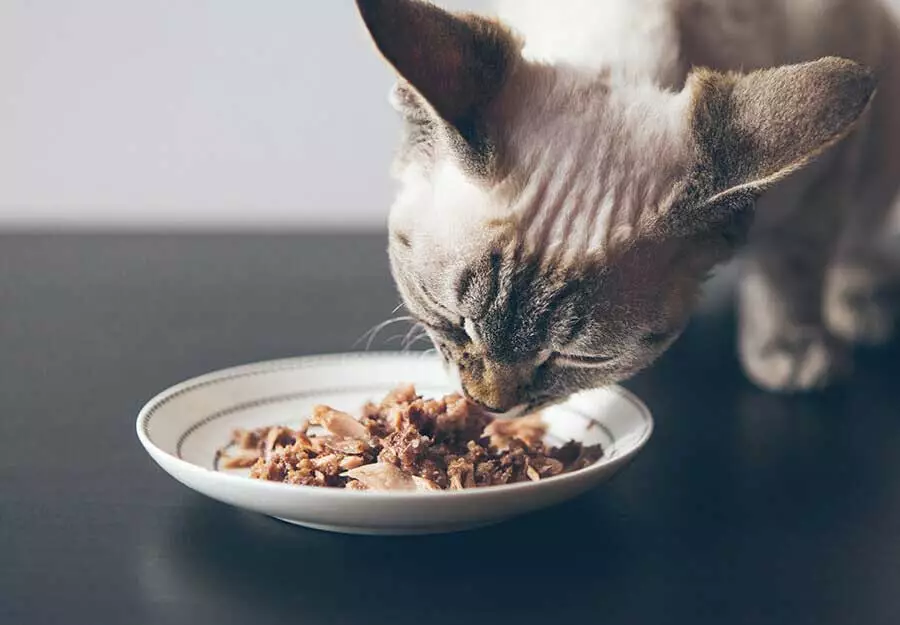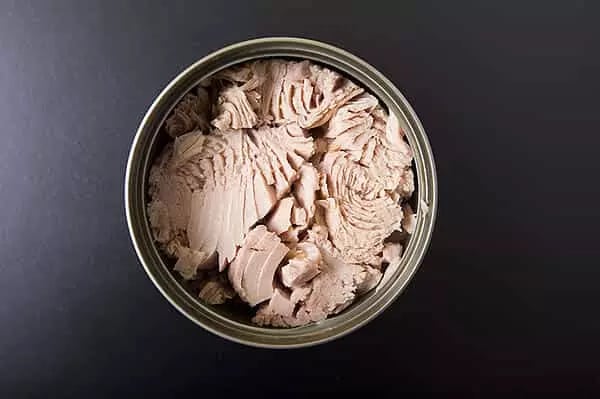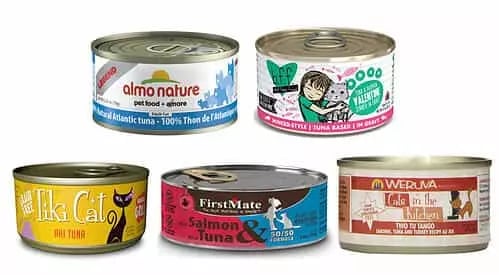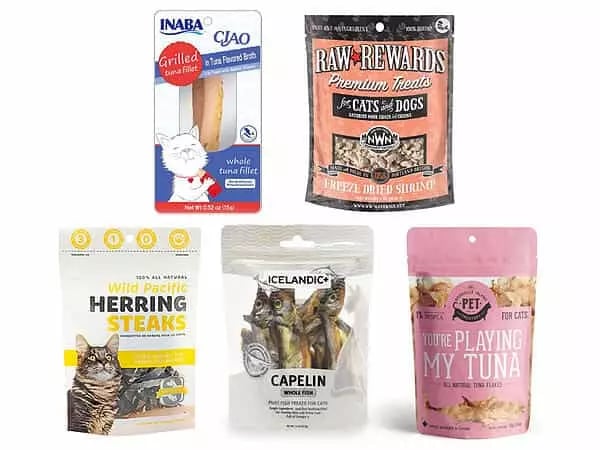
Open a can of tuna within a 5-mile radius of your cat, and she will come running. Cats love tuna, that’s a fact, but is tuna good for cats? Let’s take a look at the safety of canned tuna for cats, and some tips for kicking this mealtime habit.
Is Tuna Good for Cats?It’s a more complicated question than you might think. Offering your cat the occasional dash of tuna juice is probably not going to be an issue, but if you feed tuna more regularly, then you need to consider whether you might be putting your cat at risk.
The truth is that tuna does have some benefits other than just flavour, like:
- Calcium & Phosphorous (good for supporting hips and joints)
- Zinc
- Selenium
- B-vitamins, like niacin and riboflavin
- Potassium
- Moisture
Though these nutrients are essential for your cat, you still need to be aware of the downsides and consider whether there are better ways to offer these benefits.
The Problem with Canned Tuna for Cats

Most of us have shared a little canned tuna, or at least tuna juice, with our cats without thinking of the repercussions. They love it, they beg for it, but canned tuna is not the best way to offer your cat a fishy treat.
It’s easy to assume that canned cat food and canned tuna are not that dissimilar, but there are a few factors that make canned tuna more dangerous, so we recommend first asking is tuna good for cats? Even out of the can?
Mercury
![]()
Not all canned tuna is the same. There are different species of tuna of varying sizes, and the larger the fish, the higher the accumulation of mercury in that fish’s tissues.
The most common species of tuna offered in canned formats are Albacore, Yellowfin, and Skipjack. Yellowfin and Albacore are a much larger species of tuna, and therefore contain more mercury than the smaller tuna species, the Skipjack. Can you feed cats tuna?
If you do feed canned tuna occasionally, and we stress occasionally, try to stick to light tuna. This is what Skipjack is often labelled as.
Additives
![]()
Tuna might not the only ingredient in the can. You might see some obvious extras, like flavoured tuna or tuna packed in oil. These should definitely be avoided, but even tuna labelled as packed in water could be hiding some extra ingredients that aren’t good for your kitty.
The first one you’ll see is salt. Salt is a very common additive in canned foods. It can improve palatability, for humans, and act as a preservative for the fish. This excess salt is bad for your cat, so try to look for tuna with no salt added or low sodium.
Other quality ingredients like vegetable broth or soy are also commonly found in canned tuna too. Try to find the purest option to keep your pet safe. Better yet, avoid canned tuna altogether.
Poor Eating Habits
![]()
If your cat is a tunaholic, then you could be encouraging poor eating habits by feeding her addiction. Whether you offer tuna as a meal or just a topper, your cat may become dependent on this tasty food. She may even decide that she should only be fed tuna or food with tuna on it.
Tuna does not offer complete nutrition. Over time, a tuna-heavy diet will not provide the correct balance of nutrients, and your cat may develop health problems associated with nutrient deficiencies.
Also, having tuna as a staple in their diet can lead to body weight issues if your cat isn’t eating regularly. If your cat is overeating because of the tasty tuna topper or undereating because she is protesting her tuna-less pet food, then it will be hard for her to maintain healthy body weight and activity level. Make sure your cat is getting appropriate calories and nutrients from a complete and balanced diet. 
Unsaturated Fat
![]()
Tuna is high in unsaturated fat, like omega fatty acids. These are good types of fat, but if your cat is consuming an inappropriate amount of fat regularly, they could be susceptible to conditions like pancreatitis or steatitis, which is inflammation of the pancreas or fat tissues, respectively.
This is an especially high risk if your cat is eating a diet already rich in omega fatty acids like fish or plant oils.
5 Steps to Getting the Tuna Off Your Cat's Back
For cats that have become accustomed to their daily tuna fix, you may find that breaking this habit is not going to be pleasant but don't worry. My cat is a long-standing member of the Tunaholics Anonymous Club, and I can assure you it is possible to wean your picky cat off of her tuna dependency with minimal protesting.
Step 1: Admitting You Are the Problem
Your cat can't use a can opener. It shouldn't be a surprise that without you, there would be no tuna. We know that it's hard to say no to the desperate purrs at your feet, but cutting out the canned tuna is better for her health.
You may see some hissy fits, emphasis on the hiss, or some destructive behaviours during this recovery period, but you can free your cat of her tuna addiction with a little bit of willpower and a few sneaky substitutions.
Step 2: Breaking the Habit
So canned tuna is out, but that doesn’t change your cat’s fishy cravings. It’s time to find other ways to incorporate tuna or other fish into her diet.
Cats that depend on their tuna topper to eat are probably not going to do well with the cold turkey approach. Instead of removing the flavour burst entirely, try gradually using less and less. Then start to switch out the tuna or juice for a more appropriate topper.
For example, you can ditch the human tuna for some cat tuna. Lots of cat food brands use tuna in their wet formulas, and they would be an easy addition to your cat’s diet. Looking for some recommendations? Here are a few brands that use tuna, as well as other types of fish and seafood:

We mentioned that the mercury content of a fish is related to its size. Consider swapping out tuna for an even smaller fish, like herring, sardines, anchovies or other types of seafood and shellfish. These can also be found in canned formats from the grocery store, but it's better to look for products specifically designed for an adult cat.
Check out our full canned cat food selection to find a wet topper that your cat will love.
Step 3: Tough Love
All these changes could lead to a bit of a stand-off, so be prepared. If your kitty is feeling the tuna withdrawals, then she may refuse to eat her dinner, knowing that you will likely cave and give her what she wants.
Try not to give in immediately. Your cat can safely skip a meal or two. This might give her a chance to feel hungry enough to eat whatever you offer her.
Don't be too stubborn, though. Your cat shouldn't go without food for more than 24 hours. If she still hasn't eaten after a day, then you will have to use a more gradual approach to cutting back the tuna.
Step 4: Start a Rotational Diet
If your cat is a tuna lover, you might think feeding a tuna-based diet is the best solution. While tuna can be healthy, we also don’t recommend feeding a solely tuna diet. In fact, we don’t recommend feeding any one animal protein forever.
Rotational feeding is a great way to offer a variety of animal proteins, as well as nutrients. Tuna, and other fish, don’t provide the same nutrients that poultry or red meat do, and vice versa.
You can start with a fish-based diet to get her eating, and then gradually change to a different protein, like poultry or red meat. Changing up her protein choices every couple of months will help your cat get used to a variety of flavours while adequately balancing her nutrient intake.
This practice is common among raw feeders, but you can do it with kibble and canned diets too. Here are a few brands that offer a variety of protein choices that can easily be rotated between:
Step 5: Make Tuna Great Again
You don't have to completely turn your back on tuna, but it's best to use it sparingly and for the right reasons. Instead of topping her meals or offering this seafood snack daily, stick to using tuna as a high-value treat or reward.
In place of canned tuna, find some fishy treats that your cat will enjoy. This is a great way to train your cat as well as bond with her. You already know she loves tuna, so look into some safe and healthy fish snacks that can be used for special rewards.
There are many freeze-dried, dehydrated, and cooked fish treats that are perfectly suitable for rewarding cats. Check out some of our favourites:

These brands offer either whole, bite-sized, or freeze-dried fish that can be used for treating, playtime, and training.
If your cat is dead set on tuna, then consider trying a tuna-flavoured treat, like Wagger's My Mighty Lion or Blue Buffalo Bursts. This will allow them to enjoy their favourite flavour in a healthy and easy-to-portion treat. Check out all of our cat treats to find the right one for your cat.
Moderation is Key
Regardless of the format you choose, feeding tuna, or any fish for that matter, should be done in small doses. This limits your cat's mercury exposure and helps to prevent your cat from getting too attached to one flavour and creating picky eating habits.
When adding some extra flair to your cat's food, remember that the toppers and treats should be less than 10% of her diet. The rest should come from a complete and balanced food to ensure your cat is getting the correct nutrients that she needs to thrive.
You don't have to completely deny your kitty tuna, but make sure it's coming from the best possible source and is always fed in moderation.
Frequently Asked Questions
Can I feed my cat tuna from a can?
While a small amount of canned tuna on occasion is generally safe, it's not recommended as a regular diet.
Why is feeding too much tuna problematic for cats?
Tuna lacks taurine and other essential nutrients that cats require for their overall health. Feeding tuna regularly can result in nutritional imbalances, leading to issues such as heart problems and urinary tract complications.
Is there a specific type of tuna that's safer for cats?
If you decide to give your cat tuna as an occasional treat, choose fresh tuna, unseasoned tuna meat that has been de-boned and cleaned.
How can I incorporate tuna into my cat's diet safely?
If you want to give your cat a tuna treat, offer it as an occasional snack and ensure it's not the primary protein source.
Are there alternatives to tuna for treating my cat?
Cats love a variety of protein-rich treats and food, such as tuna-based canned cat foods, fresh meat, freeze-dried meat, or commercially available cat treats, which all provide the needed vitamins, minerals and nutrients your feline needs to thrive.
What if my cat seems to really enjoy tuna?
While cats may enjoy the taste of tuna, it's crucial to prioritize their long-term health. Look for tuna cat treats and meal toppers to satisfy your cat's tuna cravings.
.png?width=200&height=66&name=logo%20(1).png)

.jpg)
